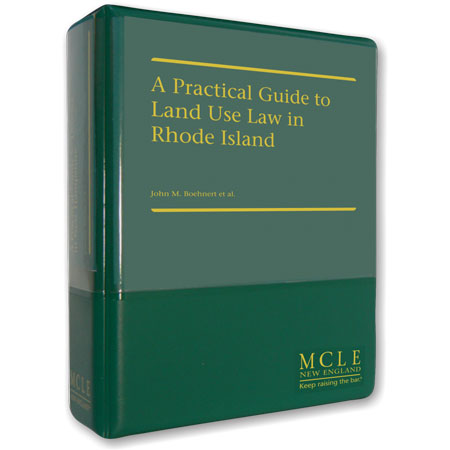A Practical Guide to Land Use Law in Rhode Island was just published this summer…

Protecting a “Million Dollar Water View” with Restrictive Covenants
While a picture may be worth a thousand words, a Rhode Island ocean view may be worth millions, if not in fact be priceless, if a little-noted Rhode Island Supreme Court decision is any indication.
In Cullen v. Tarini, 15 A. 3d 968(RI 2011), the Rhode Island Supreme Court upheld a plaintiff’s efforts to enforce a restrictive covenant plaintiff placed on property before selling it in order to limit the location, size, and height of any structure that could be built on the land being sold.
The reason? The property plaintiff retained and did not sell “is very nearly the highest point on Aquidneck Island” with “a grand vista that looks out to the south and the southeast that has direct ocean views that are spectacular”. Construction on the property plaintiff was selling had to be limited in order to prevent it from blocking the ocean views of the property plaintiff was retaining.
When the first purchaser found that plaintiff would not modify its restrictions, it sold the lot without constructing a residence. The new buyer was less reserved.
The new buyer engaged a designer/builder to construct a significant residence, but according to trial testimony did not advise the designer of the restrictive covenants of record limiting construction, such as size and height, and only advised him that the house should be built in a designated area, but that these were “general guidelines only”.
The buyer did have discussions with the plaintiff and even showed him plans for the new residence, but the plaintiff said the plans were insufficient for him to understand that they violated the restrictions and the buyer did not tell the plaintiff that his plans violated the restrictions. In the words of the Supreme Court, the defendant buyer “ testified that he knew about at least two of the violations at the time of the October 2007 meeting between the parties, before beginning construction, and that he chose to ‘subtly ‘wait for the plaintiff to discover the violations rather than directly notify the plaintiff of them.”
Construction proceeded pursuant to plans that exceeded the height limitation, square foot limitation, and location limitation of the restrictive covenant. When plaintiff became aware of the violations, plaintiff sued for an injunction, which was granted. At that point, the new buyer had spent $1,250,000 on construction of the partially completed residence.
The trial court found for the plaintiff and ordered the offending construction removed. The Supreme Court upheld that decision, rejecting a number of challenges.
Significantly, the Court found that the in order to enforce restrictive covenants it was not necessary to make a separate finding of irreparable harm to the plaintiff. Quoting from the Restatement (Third) of Property Law, the court said “[t]he value of a restrictive covenant often is subjective and difficult to evaluate in monetary terms. For this reason, injunctive relief is an appropriate remedy so long as the purpose for which the restrictive covenant was created continues to exist”.
The Court also found that it was not necessary to balance the equities between plaintiff and defendant in a restrictive covenant case, as “proof of a violation of a restrictive covenant was sufficient for a court to grant injunctive relief”.
So it was a good day in court for restrictive covenants, not to mention ocean views.
And regarding the cost of that ocean view, in addition to the $1,250,000 the buyer spent on partial construction of its residence, some of which had to be redone and removed, the buyer was also ordered to pay plaintiff’s legal fees and other expenses in enforcing its rights under its restrictive covenants.
So by all means, use restrictive covenants when appropriate to protect water view property or other important view corridors and property interests. And if you acquire real estate subject to restrictive covenants, for goodness sake, be careful!




